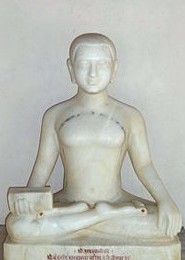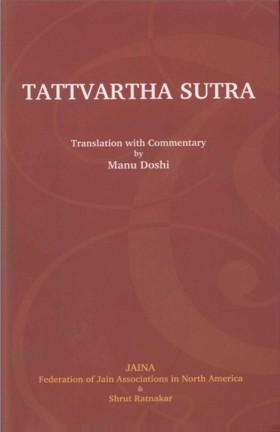02.37 Audārikvaikriyāhāraktaijaskārmanāni Sharirāni
Audio: Sanskrit: औदारिकवैक्रियाआहारकतैजसकार्मणानि शरीराणि ।
Hindi: औदारिक, वैक्रिय, आहारक, तैजस और कार्मण - ये पांच प्रकार के शरीर हैं ।
02.38 Param Param Sukshmam
Audio: Sanskrit: परं परं सूक्ष्मम्
Hindi: इन पांच प्रकारों में पर पर अर्थात आगे आगे का शरीर पूर्व-पूर्व से सूक्ष्म है!
02.39 Pradeshato'sankhyeyagunam Prāk Taijasāt
Audio: Sanskrit: प्रदेशतोअसंख्येयगुंण प्राक् तैजसात् ।
Hindi: तैजस के पूर्ववर्ती तीन शरीरों में पूर्व-पूर्व की अपेक्षा उत्तर उत्तर शरीर प्रदेशों (स्कन्धों) (की अपेक्षा) से असंख्यातगुण होता है ।
02.40 Anantgune Pare
Audio: Sanskrit: अनन्तगुणे परे ।
Hindi: परवर्ती दो अर्थात तैजस और कार्मण शरीर प्रदेशों (की अपेक्षा) से अनन्तगुण होते हैं ।
02.41 Apratighāte
Audio: Sanskrit: अप्रतिघाते ।
Hindi: तैजस और कार्मण दोनों शरीर प्रतिघात रहित है।
02.42 Anadisambandhe Cha
Audio: Sanskrit: अनादिसम्बन्धे च ।
Hindi: आत्मा के साथ अनादि सम्बन्धवाले है।
02.43 Sarvasya
Audio: Sanskrit: सर्वस्य ।
Hindi: सब संसारी जीवों के होते हैं।
02.44 Tadādini Bhajyanī Yugpadekasyā Chaturbhyah
Audio: Sanskrit: तदादीनि भाज्यानि युगपदेकस्याचतुर्भ्य: ।
Hindi: एक साथ एक जीव के तैजस और कार्मण से लेकर चार तक शरीर विकल्प से होते है।
02.45 Nirupabhogamantyam
Audio: Sanskrit: निरूपभोगमन्त्यम् ।
Hindi: अंतिम अर्थात् कार्मण शरीर उपभोग (सुख दुःखादि के अनुभव) से रहित है।
02.46 Garbhasammoorchhanjamadyam
Audio: Sanskrit: गर्भसम्मूर्छनजमाद्यम् ।
Hindi: अंतिम अर्थात् कार्मण शरीर उपभोग (सुख दुःखादि के अनुभव) से रहित है।
02.47 Vaikriyamaupapātikam
Audio: Sanskrit: वैक्रियमौपपातिकम् ।
Hindi: वैक्रिय शरीर उपपातजन्म से होता है।
02.48 Labdhipratyayam Cha
Audio: Sanskrit: लब्धिप्रत्ययं च ।
Hindi: वह (वैक्रिय शरीर) लब्धि से भी होता है।
02.49 Shubham Vishuddhamavyāghāti Chāhārakam Chaturdashapoorvadharasyaiva
Audio: Sanskrit: शुभं विशुद्धमव्याघाति चाहारकं चतुर्दशपूर्वधरस्यैव ।
Hindi: आहारक शरीर शुभ (प्रशस्त पुद्गल द्रव्यजन्य), विशुद्ध (निष्पाप कार्यकारी) और व्याघात (बाधा) रहित होता है तथा वह चौदहपूर्वधारी मुनि के ही होता है।
02.37-49
English: These 13 sutras deal with different types of bodies. Organic bodies that we normally come across are termed as Audārik. That is obtained by Garbhaj and Sammoorchchhim beings. Protean bodies held by the heavenly and infernal beings are termed as Vaikriya. Such bodies can also be assumed by the accomplished beings. Carrier bodies assumed by highly accomplished monks are termed as Ahārak. They are very subtle, are made of pure particles and are assumed by competent personages for taking themselves to the omniscient Lords for resolving their doubts. Such bodies are wholesome, adorable and not subject to any hindrance or obstruction.
The remaining two bodies are termed as Taijas and Kārman. The mechanism that provides luster as well as warmth and is helpful in metabolic process is termed as Taijas body. One that is composed of the particles of Karma is termed as Kārman body. These two types are associated with all the worldly souls. They are so subtle that they can pass through the hardest matter. The Kārman body is the cause of pleasure and pain, but it does not experience those feelings. Experience is a function of senses and brain.
Audārik body is gross, Vaikriya is fine, Āhārak is subtle, Taijas is subtler and Kārman is the subtlest. Every worldly being can have two, three or four types of those bodies. Taijas and Kārman bodies are invariably associated with all the worldly beings and stay with them even during the transit from one life to another. In other states, a worldly soul must also have an Audārik or a Vaikriya body. As such, it has at least three types of bodies. Moreover, an accomplished being can assume Ahārak body. In that case he would have four bodies, viz. Āhārak, Vaikriya, Taijas and Kārman or Ahārak, Audārik, Taijas and Kārman bodies.
 Acharya Umaswati
Acharya Umaswati
